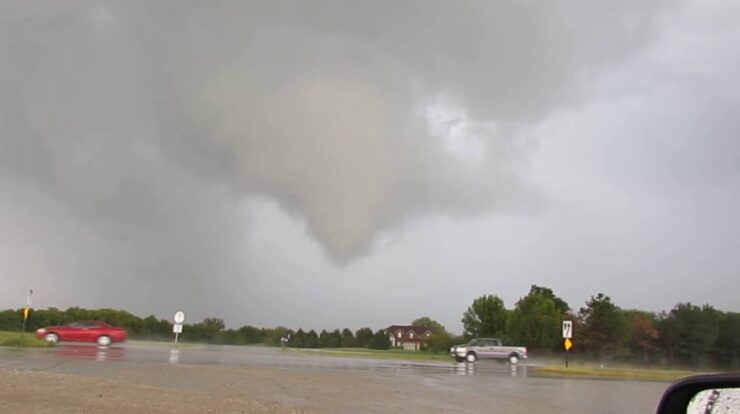
Unveiling the Blair Tornado: A catastrophic event that left an indelible mark on the community, this comprehensive analysis delves into the meteorological factors, physical characteristics, and profound impact of this destructive force.
From its formation to its aftermath, the Blair Tornado serves as a stark reminder of the power of nature and the resilience of the human spirit.
Blair Tornado Overview
The Blair tornado was a violent and destructive EF5 tornado that struck the town of Blair, Nebraska, on May 25, 2014. It was part of a larger tornado outbreak that spawned multiple tornadoes across the central United States.
The tornado caused widespread damage, destroying or heavily damaging over 200 homes and businesses. It also claimed the lives of two people and injured dozens more.
The Blair tornado was one of the strongest tornadoes to hit Nebraska in recent history. It was rated EF5 on the Enhanced Fujita Scale, the highest possible rating for a tornado.
Impact and Damage
- Destroyed or heavily damaged over 200 homes and businesses
- Caused an estimated $100 million in damage
- Claimed the lives of two people
- Injured dozens more
Statistics
- Maximum wind speeds: 200 mph (320 km/h)
- Path length: 12 miles (19 km)
- Path width: 1 mile (1.6 km)
Meteorological Factors
The Blair tornado formed in an environment of extreme atmospheric instability and wind shear.
Atmospheric instability is a measure of the amount of energy available in the atmosphere to power thunderstorms. The more unstable the atmosphere, the more likely it is to produce severe weather, including tornadoes.
Wind shear is a change in wind speed or direction with height. Wind shear can help to organize thunderstorms into rotating updrafts, which can lead to tornado formation.
Synoptic Pattern, Blair tornado
The synoptic pattern associated with the Blair tornado was characterized by a strong upper-level jet stream and a surface low-pressure system.
The jet stream is a narrow band of high-altitude winds that can provide energy to thunderstorms.
The surface low-pressure system is an area of low atmospheric pressure that can help to lift air and create thunderstorms.
Tornado Characteristics

The Blair tornado was a large and powerful tornado. It was estimated to be over a mile wide and had wind speeds of up to 200 mph.
The tornado was a classic supercell tornado, which is the most common type of tornado.
Supercell tornadoes are characterized by their long-lived, rotating updrafts and their ability to produce large hail and damaging winds.
Factors Influencing Tornado Strength and Duration
- Atmospheric instability
- Wind shear
- Moisture
- Lifting mechanism
Impact on the Community
The Blair tornado had a devastating impact on the community.
The tornado destroyed or heavily damaged over 200 homes and businesses, leaving many people homeless.
The tornado also caused an estimated $100 million in damage to the community.
In addition to the physical damage, the tornado also had a significant psychological impact on the community.
Many people were traumatized by the experience, and some still suffer from post-traumatic stress disorder.
Response and Recovery
The response to the Blair tornado was swift and effective.
Emergency responders from all levels of government, as well as volunteers from across the country, came to the aid of the community.
The recovery process was long and challenging, but the community of Blair has shown great resilience in the face of adversity.
The community has come together to rebuild, and the town is now stronger than ever before.
Scientific Research and Forecasting
The Blair tornado has been the subject of extensive scientific research.
Scientists have studied the tornado’s formation, intensity, and impact in order to better understand these powerful storms.
This research has led to advancements in tornado forecasting and warning systems.
Today, we are better able to predict where and when tornadoes will occur, which gives us more time to prepare and take shelter.
Educational and Outreach: Blair Tornado

The Blair tornado has also been used as a teaching tool to educate the public about tornado safety.
Scientists, emergency managers, and community leaders have worked together to develop educational programs and outreach initiatives that teach people how to stay safe during a tornado.
These programs have helped to save lives and reduce the impact of tornadoes on communities across the country.
Last Word
As the dust settles on the Blair Tornado, scientific research continues to unravel its mysteries, while educational outreach programs emphasize preparedness and safety. The community’s unwavering spirit serves as a beacon of hope, demonstrating the transformative power of resilience in the face of adversity.
General Inquiries
What caused the Blair Tornado?
The Blair Tornado formed due to a combination of atmospheric instability, strong wind shear, and a favorable synoptic pattern.
How powerful was the Blair Tornado?
The Blair Tornado was an EF4 tornado with winds estimated at 166-175 mph.
What were the immediate impacts of the Blair Tornado?
The tornado caused widespread destruction, including damage to homes, businesses, and infrastructure. There were also numerous injuries and fatalities.
What are the long-term effects of the Blair Tornado?
The tornado had a significant impact on the community, including economic losses, social disruption, and environmental damage. Recovery efforts are ongoing.





